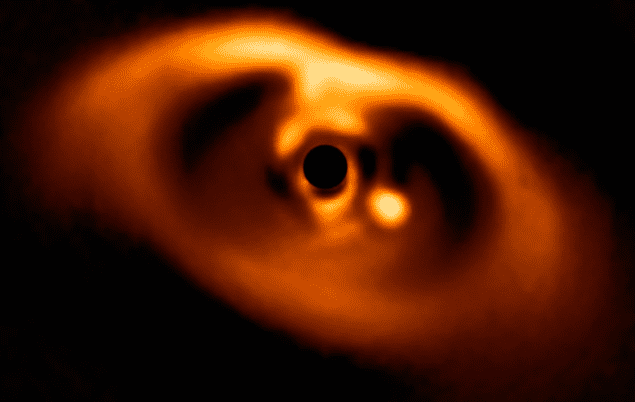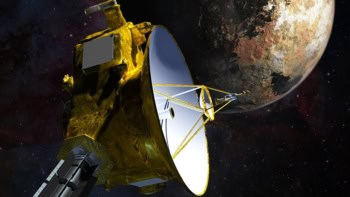
A newborn planet orbiting a star just 370 light-years from Earth has been spotted by astronomers using the European Southern Observatory’s Very Large Telescope (VLT) in Chile. Dubbed PDS 70b, the huge planet is the first-ever to be seen orbiting within a disc of planet-forming material. Its discovery could provide important clues as to how systems of planets form around stars.
PDS 70b is a gas giant with a mass that is believed to be several times that of Jupiter. It orbits a very young star called PDS 70, which is about 10 million years old and is surrounded by a dense protoplanetary disc of dust and gas. The disk appears to have a void near its centre, which has probably been cleared by the young planet. Astronomers have known about such voids for decades and have long speculated that they are associated with young planets.
Birthplaces of planets
“These discs around young stars are the birthplaces of planets, but so far only a handful of observations have detected hints of baby planets in them,” explains Miriam Keppler of Germany’s Max Planck Institute of Astronomy in Heidelberg, who led the team that discovered PDS 70b. She adds, “The problem is that until now, most of these planet candidates could just have been features in the disc”.
The discovery inspired a follow-up study that was led by Keppler’s Heidelberg-based colleague André Müller and looked more closely at PDS 70b and how it interacts with the planetary disc. This revealed that the planet is orbiting in the middle of the void at a distance of about 22 au from the star – which in the solar system would put it just beyond Uranus.
The surface temperature of PDS 70b is about 1000 °C and the radius of the planet is 1.4-3.7 times that of Jupiter. According to Müller and colleagues, the upper limit is somewhat greater than expected for the age of the planet – which they estimate to be 5.4 million years. Spectroscopic studies of light from the planet suggest that it has a cloudy atmosphere.
600 young stars
The observations were done using SPHERE, which is a planet-hunting instrument on the VLT that was used by two astronomical survey programmes to study PDS 70. One is called SHINE – which aims to take near-infrared images of 600 nearby young stars in a search for new planets. The other is called DISK, which looks at young planetary systems and protoplanetary discs.

Optical ‘astrocomb’ could boost searches for Earth-like planets
SPHERE detects the faint light from planets by first blocking the much brighter light from the parent star using a coronagraph. Then a series of images is taken of the system over time. The position of the planet will change slightly as it moves in its orbit, while the star will appear stationary. By looking at how the image changes with time, astronomers can extract the light from the planet and reject light from the star.
The studies will be described in two papers to be published in Astronomy & Astrophysics and preprints are now available: Miriam Keppler et al; and André Müller et al.



